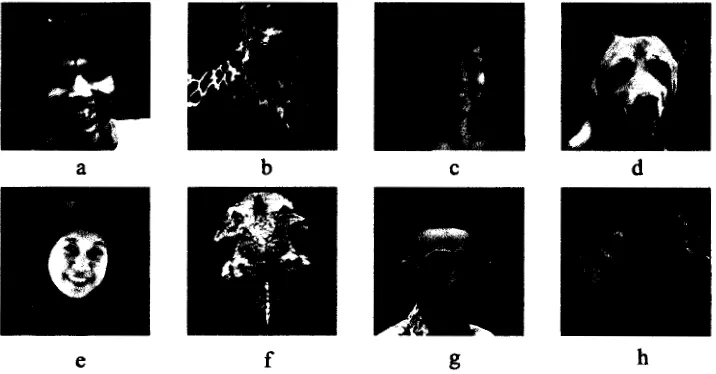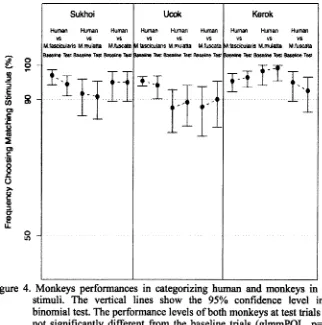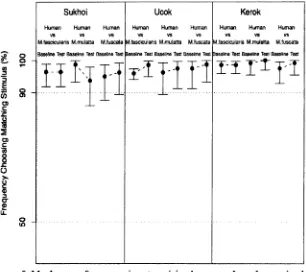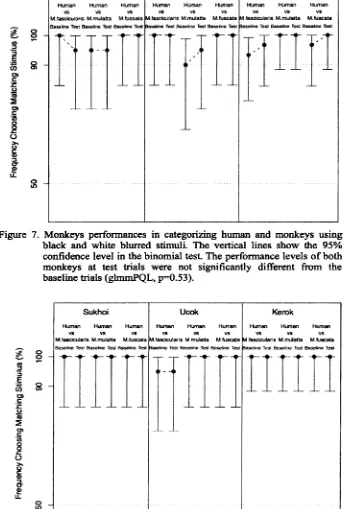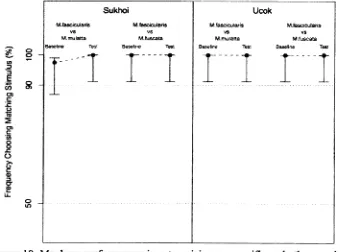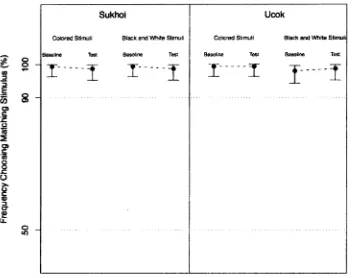ISSN 0912-4047
Symposium of Primate Society of Japan, July 7th-8'\ Japan. 1
MULTIPLE LEVELS OF CATEGORIZATION IN LONG TAILED
MACAQUE (Macaca fascicularis)
Kanthi Arum Widayati1
, Bam bang Suryobroto1, Achmad Farajallah1,
Akichika Mikami2
1. Bogor Agricultural University, Indonesia
2. Chubu Gakuin University, Japan.
INTRODUCTION
We live in a world full of ever-changing objects. It is impossible for us to memorize each and every new individual we encounter. One way to overcome the memory storage constraint is to represent factual objects as conceptualized mental images. A concept concludes a lot of informations that had been collected at the time we perceive the object and abstracts them to assist the process of grouping individuals or events into different categories (Rosch et a/. 1976). There are several levels of categorization and within a taxonomy the levels are nested (Rosch et al. 1976). At the most concrete level of categorization, all or most members of the category shared common physical attributes that differ from other category. The higher the level of category, the fewer common attributes between members of the group.
In addition to humans, the ability to categorize has also been proposed for animals. Being able to identify, visually or otherwise, a new object as a member of a category is an advantage for animals. It should help them to distinguish between food or non-food, and to discriminate between species of animal. This species discrimination is important to prevent hybridization among species (Yoshikubo 1985, Fujita and Watanabe 1995, Fujita eta/. 1997).
Present experiment aims to test the ability of species discrimination by M
fascicularis in discriminating dichotomous-stimuli of two different classes of
Symposium of Primate Society of Japan, July 7th-8th, Japan. 2
monkeys are able to categorize monkey individuals as a class against human
individuals as another class. Second, we tested whether they able to discriminate
between their conspecific from other macaque species. Third, we tested their
ability to categorize animal as non-human class against human individuals as
human class.
METHODS
Using operant conditioning method Reynolds (1975), we trained monkeys
to associate sample and matching stimuli against distractor stimulus. First, we
showed monkeys a sample stimulus as reference to be matched (Figure la). To
ensure that the subjects paid attention to the sample stimulus, they had to touch
the sample stimulus and for this they received reward that they may find beneath
the stimulus. Next, we presented side-by-side matching and distractor stimuli
which one had to be chosen by the subjects. When the subjects chose the
matching stimulus, they received food as a reward; the response was counted as a
correct one. When they chose the distractor, they did not get any rewards.
Subject's motivation for reward warranted the choice of the matching stimulus.
a Baseline trial b. Test trial
Symposium of Primate Society of Japan, July 7th-8th, Japan. 3
We repeated the trials consecutively with inter-trial intervals for about 30 second.
The location of matching and distractor stimuli on the tray was arranged
pseudorandomly. We blocked every 20 trials into one session and measured their
correct rate. If the subject chose the matching stimuli higher than 90% in a
session, it means they were able to associate matching to sample stimuli.
Human vs Macaques
a
b
c
d
[image:4.599.152.504.258.444.2]e
fg
h
Figure 2. Example of stimuli used for Human vs Macaques experiment. a and b were a pair of stimuli used in baseline trials. Both photos could be sample and matching stimuli, depended on the trials. These stimuli were also used as sample stimuli in test trials. c to h were example of matching stimuli in test trials. c, e and g were the example of human stimuli. d, f and h were example of monkey stimuli. d was example of photos of M. fascicularis, while f and h were example of M. mulatta and M. foscata,
respectively.
For training phase, sample and matching stimuli were the same and
monkey's stimuli were always M fascicularis (see figure 2b and 2d). To test if a
subject could apply the learned concept of human and monkeys to new
individuals, we changed the pictures of matching stimulus with different
individuals that belonged to the same category as the sample stimuli (ex: figure
2c , 2e, 2g). To test whether the subjects have multilevel abstraction, we deviced
extended experiments that stripped off certain visual information from the stimuli.
First, we took color off the photos and presented it in black and white. In the next
step, we reduced the size of the stimuli to one quarter of the original and showed
Symposium of Primate Society of Japan, July 7th-8th, Japan. 4
and M fascicularis. We continued our test by giving the subjects the blurred,
black and white, original size photos of human and macaques. In our last attempt to ascertain whether the subjects could categorize human differently from macaques, we reduced the size of the black and white, blurred photos of human and monkeys to one quarter of the original size. Thus, by comparing subject's responds to complete and reduced information stimuli, we may interprete their level of categorization. In total, we used 82 photos as the stimuli for the test.
M. fascicularis vs Other Macaques
In this experiment, we assesed categorization ability of M fascicularis to discriminate their own species from other species of macaques. In this experiment, we used several facial photos of M fascicularis, M mulatta and M
foscata. We did this in two conditions, that is in color and black and white. Same
as the first experiment, the test session consisted of certain proportion of baseline and test trials. In baseline trials of both paradigms, the photos of matching stimuli were the same to sample stimuli. In total, we used 40 photos as the stimuli for the test.
Human vs Non-Human
In this experiment, we assesed categorization ability of M fascicularis to
a
e
b
エᆱセ@
セ@ ' ,;:.,
.. lGGGZ[セ[N[ᄋスNN@
セᄋᄋ@
;LNLNNセ@
i
f
c
g
Figure 3. a to h were example of stimuli used in human vs non-human experiments. d
[image:5.599.139.497.527.714.2]Symposium of Primate Society of Japan, July 7th-8'h, Japan. 5
discriminate various kinds of animals from human using facial features. In this experiment, we used several photos of human (see the first experiment) and non-primate animals, such as mammals, reptiles and amphibians (Figure 3). As in the second experiment, we did this in color and black and white. In test trials, we changed the pictures of matching stimulus with different individuals that belonged to the same category as the sample stimuli; for example, if the sample stimulus was monkey 2b then the matching stimulus was animal 3a. The subject should compare the novel matching stimulus to the available distractor. If the subject could associate the sample and the different-picture of matching stimuli, we may infer that they put those two pictures into one class that dichotomically differs from the class of distractor. This would mean they are able to categorize non-human animals differently from non-human. The baseline stimuli were the same stimuli used in Human vs Macaques experiment (see Figure 2). In total, we used 68 photos as the stimuli for the test.
Subjects
The subjects were two adult M fascicularis males, named Ucok and Sukhoi and one female named Kerok. Both male monkeys were maintained at the Department of Biology of Bogor Agricultural University. The female monkey was maintained at Primate Researh Institute, Kyoto University. They were reared in individual cages and tested in the same cage. Experiments were conducted according to the Guide for the Care and Use of Laboratory Animals by the National Institute of Health, U.S.A. (1985), and the Guide for the Care and Use of Laboratory Primates by the Primate Research Institute, Kyoto University (1986, 2002). The training phase was held about two years for Ucok and one year for Sukhoi and two months for Kerok depend on the ability of learning of the monkeys. The test phase was conducted for few months for all monkeys.
Data Analysis
Symposium of Primate Society of Japan, July 7th-8'\ Japan. 6
and false when they choose distractor stimulus. This binomial responses were dependent on stimuli presented in baseline and test trials; we therefore treat baseline and test trials as independent variables and the effect of individuals in the analysis as random effect. Thus, we used Generalized Linear Mixed Model (GLMM, Venables and Ripley 2002) using R software version 2.10.1 (R Development Core Team 2010) to analyze our discrete, binomial data.
RESULTS
Human vs Macaques
Symposium of Primate Society of Japan, July 7th-8'\ Japan. 7 means the subjects did not affected by the reduction in size of the stimuli.
We continued our test by giving the subjects the blurred and black and white original size photos of human and macaques. We found that the subjects were able to categorize human separately from monkeys. Their performance in both baseline and test phases were the same (glmmPQL, p=0.53) (Figure 7).
In our last attempt, we reduced the size of the black and white, blurred photos of human and monkeys to one quarter of the original size. We found that even in condition lacking important physical informations, such as color, shape and size, their performance in both baseline and test phases were the same
Sukhoi Ucok Kerok
Human Human Human Human Human Human Human Human Human
V$ V$ V$ V$ V$ V$ '1$ '1$ '1$
MJascicuiaris M mulal!a M.lusc<Jia M !aseicu!ans M molalla MJuscala M.!aseicu!ans M.mulal!a MJuscata
t
00
!
... :; E g -:;:; CJ) a c: l'!i
- l i ! t t - T o i i i - T e l l -ll!o!-T<!st-nell!o! - T e i i - T C $ 1 - T i l l t
IIIrii
I
1
liii
III
III
セ@ a c: w
セ@
(.)>-セ@
::;) cre
u.. 0 (()Figure 4. Monkeys performances in categorizing human and monkeys in color stimuli. The vertical lines show the 95% confidence level in the binomial test. The performance levels of both monkeys at test trials were not significantly different from the baseline trials (glmmPQL, p=0.15, Venables and Ripley 2002).
[image:8.599.145.467.328.653.2]Symposium of Primate Society of Japan, July 7th-8'\ Japan.
Sukhoi Ucok Kerok
Human Human Human Human Human Human Human hセセョ。ョ@ Human
'IS
..
""
'IS \'S..
'IS 'IS \ISmセイゥウ@ M.mulatta M.ll.lscata セu。ウ、」Zオゥ。イゥウ@ M.mulalt8 M.lustata セMA。ウ、」Zオャ。イゥウ@ M.mulat!a M.fll!iCa!a
t
8
!! ,...
1
:;I gen
0)
c:::
- l o s t - 1 0 > 1 - T I I t l a-m Toot
-111>1-
rest flaool<lle 10>1- TOOl- T'"": IIIfli
:r
1
JIII
I-II·!
I-I
" ' " ' .. " " ' " ' ..
_L
:.E j :::!
0)
c:::
"l)l
セ@
0
f
::1l
f5
-Figure 5. Monkeys performances in categorizing human and monkeys using black and white stimuli. The vertical lines show the 95% confidence level in the binomial test The performance levels of both monkeys at test trials were not significantly different from the baseline trials (glmmPQL,
p=0.19).
SukhOi
Hu"""'
'IS
M.tasocu!a1s
!lassJino TOOl
:-I --
-r
Ucok Kerok
I----r
Figure 6. Monkeys performances in categorizing human and monkeys using
resized stimuli. The vertical lines show the 95% confidence level in
the binomial test. The performance levels of both monkeys at test trials were not significantly different from the baseline trials (glmmPQL, p=0.85).
[image:9.599.146.452.116.388.2] [image:9.599.147.466.453.713.2]Symposium of Primate Society of Japan, July 7th-8'\ Japan.
Sukhoi Ucok Kerok
Human HUman Human HUman Human HUman HUman HUman Human
w w w w w w セ@ w w
M.lasclcu!aris M.mulal!a MJuscala MJascicularis M.mulatta J.Uuscata M.lasdcularls M.mutatta MJuscata
i:
8! ... セ@ li セ@ Q) c :f!
---セ@
rc- -c
II II
セNセイ@
Ir-·I
II
JI
it
2 Q)·i
.§
--0
f
:::l r::re
u.Figure 7. Monkeys performances in categorizing human and monkeys using
black and white blurred stimuli. The vertical lines show the 95%
confidence level in the binomial test. The performance levels of both monkeys at test trials were not significantly different from the baseline trials (glmmPQL, p=0.53).
Sukhoi Ucok Kerok
Human Human Human Human Human Human Htm1an Human Human
w w セ@ w w w セ@ w w
M.-!aris M.mulatta M.IUsca!a M.lascieulans M.roulalla M.tuscata mNA。ッッャ」オA。セッ@ M.mulatta M.luscata
l
0セ@:;) セ@ E li +=I en Nセ@ .c
---セ@
II II Ire_:-II
r
II II II
セ@
::z
0'>
--
'-c ·;;; .§ (.)
f
6-セ@ 0 1.()Figure 8. Monkeys performances in categorizing human and monkeys using resized, blurred, black and white stimuli. The vertical lines show the 95% confidence level in the binomial test. The performance levels of both monkeys at test trials were not significantly different from the baseline trials (glmmPQL, p=0.57).
[image:10.599.148.481.123.392.2] [image:10.599.140.483.145.654.2]Symposium of Primate Society of Japan, July 7th-8'\ Japan. 10
M. fascicularis vs other macaques
This experiment aimed to test the ability of monkeys in categorizing M
fascicularis differently from other macaque species. In this experiment we used
two paradigms, that is, M fascicularis vs M mulatta and M fascicularis vs M
fuscata. In baseline trials of both paradigms, the photos of matching stimuli were
the same to sample stimuli. We found that all subjects associate sample stimulus to new individuals of matching stimuli (Figure 9). This same result to baseline (glmmPQL, p=1) indicate that subjects were able to correctly identify new individuals as members of their respective class. This would mean that the subjects categorized M fascicularis differently from the two other macaques.
As in the first experiment, we ascertained this categorization ability by taking color off the photos. We found that all subjects associate sample stimulus to black and white version of the matching stimuli (Figure 1 0). This same result to baseline (glmmPQL, p= 1) would indicate that even without color, the subjects could also categorize M fascicularis differently from other macaques.
Human vs Non-Human
Symposium of Primate Society of Japan, July 7th-8'\ Japan.
Sukhoi Ucok
M.fasdcurarill M.fasdcurarill MJasci<:ulans M.lasdculans
vs VII 'JS vs
M.mula!!a MJuscalll M.mula!la M.fuscala
l
-
Thl-
Test-
T""'_,
Tag
セ@
r--]
r----I
r--]
!
- r--::1
E
8
';:".l
-(fj
C) c: 2!!
セ@ '
-:e C)
c:
_
...'ij
.§
0
>-セ@
::1 tT
e
u..
0
[image:12.599.139.483.113.394.2]-10
Figure 9. Monkeys performances in categorizing conspecific and other monkeys using colored stimuli. The vertical lines show the 95% confidence level in the binomial test. The performance levels of both monkeys at test trials were not significantly different from the baseline trials
Sukhoi Ucok
Figure 10. Monkeys performances in categorizing conspecific and other monkeys using black and white stimuli. The vertical lines show the 95% confidence level in the binomial test. The performance levels of both monkeys at test trials were not significantly different from the baseline
trials (glmmPQL. p=l).
[image:12.599.144.484.460.712.2]Symposium of Primate Society of Japan, July 7th-8'\ Japan.
Sukhoi Ucok
!Jlad( and Whit& Sbmuo
r----
-1
Figure 11. Monkeys performances in categorizing human and non-human using
colored and black and white stimuli. The vertical lines show the 95%
confidence level in the binomial test. The performance levels of both monkeys at test trials were not significantly different from the baseline trials (glmmPQL, p=0.65 for colored stimuli and p=0.70 for black and white stimuli).
[image:13.599.130.482.136.414.2]Symposium of Primate Society of Japan, July 7th-8'\ Japan. 13
DISCUSSION
Our first experiment to show the ability of categorization in M
fascicular is was the discrimination of human vs monkey. In the training phase, we
introduced pictures of human and monkey to subjects. There were consistent similarities and differences of physical properties between human and monkey pictures. It is not unreasonable to conclude that our subjects used these similarities and differences to create a conceptualized mental image of human that differs to that of monkey. There are some physical properties that provide information to create concepts. First is shape. The global and local shapes of human's and monkey's faces are very different. While human faces are oval, monkey's faces are rounded with hair on it. Another possibility is that the subjects detected the presence of the eye. This mechanism, called "eye direction detector", is important to understand facial emotion (Farroni et al. 2002, Baron-Cohen et al. 1999). Given the eyes, its angles with nose and lips of both species are different. The second is color. In this experiment, we used colored photographs. As seen in stimulus photos (Figure 2), compared to uniformly presented background color, the global color of the monkeys was different to that of human. Indeed, this had been shown by Santos (200 1) that colors are used as information to categorize object. Those informations may help subjects to recognize and discriminate between categorically human and monkey.
The resulting concepts of human and monkey developed from training phase were used by our M fascicularis individuals as basis to categorize pictures in the test phase. In every trial of test phase we changed the baseline pictures with new ones. This would prove the ability of subjects to transfer its concepts to respond to novel stimuli. For monkey pictures, we used three different species of macaques. We found that proceeding from baseline to test trials performance of our subjects remained the same. These indicate that our subject categorized monkey as monkey and human as human. It is interesting to note that although two of our subjects (M fascicularis) never saw other species (M fuscata and M
Symposium of Primate Society of Japan, July 7th-81
\ Japan. 14
instead of human which in captivity they see everyday. It might be concluded that they had concepts of human and monkey based on different color and shape of the stimuli. We may interprete this fact as the monkeys recognized natural discontinuity between the two class; Rosch et al. 1976 called this as basic level of abstraction. As this kind of categorization ability was based on perceptual similarity of physical attributes of the photos discussed above we may also describe this as the concrete level of abstraction (Vonk and MacDonald 2002,2004).
Symposium of Primate Society of Japan, July 7th-8'\ Japan. 15 goes to the more abstract levels, it share less properties among each other. Thus, we may follow that the use of global shape is one way monkey used to generalize the physical properties of an object. To test whether our subjects might be able to generalize their physical percepts, we blurred or resized the stimuli to reduce and/or to change the local shape informations carried by the stimuli. Again, in all of these extended tests, our M fascicularis subjects showed high performance of discrimination. This ability to classify blurred or resized photos of human as human and blurred or resized photos of monkey as monkey demonstrated that the subjects were looking for features of blurred or resized matching stimulus that have common properties with those of sample stimulus. It seemed that our subjects substracted the local shape differences to get a generalized concept of object. Our experiment showed that our subjects performs at least two levels of categorization by learning from their experience in training and test phases.
For second experiment, we tested the ability of M fascicularis m discriminating M fuscata or M mulatta against their conspecific. Those macaques belong to fascicularis group (Fooden 1969) so they shared many similar physical properties of face, such as the existence of facial hair and other local shapes. Thus, the monkeys have to extract the differences from total facial properties to get the uniqueness of each species. Result of the experiment showed that monkeys could discriminate their conspecific from other species. They may used color as information, since the hair color of M fascicularis in the stimuli were lighter than that of M mulatta and darker from M fuscata. More over, the facial color of M
fascicularis is relatively brownish while M mulatta paler and M fuscata reddish.
Symposium of Primate Society of Japan, July 7th-8'\ Japan. 16 The Human vs Macaques and M fascicularis vs Other Macaques experiments showed that our M fascicularis able to develop concept using informations from similarity and difference of physical properties to put objects into one particular class. However, in some conditions, it takes more than physical similarity to put objects into one group. One object may relate to others based on relations that could not be detected easily by sensory properties. Thus, in this case, subjects need the ability to associate different conceptualized mental images to discriminate stimuli lacking in physical clues. The class that is created does not rely on perceivable features and may reflect a more conceptual understanding of category belongingness. This kind of concept assisted higher level of categorization. To test whether our M fascicularis were able to create such a more abstract concept, we did Human vs Non-Human experiment. In two previous experiments, there are physical similarities between all sample and matching stimuli. In Human vs Non-Human experiment, we dismissed physical similarities within one category; that is, Non-Human class consisted of photos of animals such as mammal, bird, reptile and amphibian which were different in many ways. At first we tested them with colored stimuli. Our subjects showed high performance in discriminating between human and non-human classes. Since there are no similarity within non-human category, we may suspect that our subject use color information to do categorization. Still, if we took color off the stimuli, our subjects discriminated non-human from human. We assumed that the monkeys created a new concept, that is concept of non-human that differ from
concept of human. Thus, the result clearly showed that our subjects could perform
higher level of abstraction.
CONCLUSION
Our studies showed that our M fascicularis able to discriminate several species of animal. They did it by creating concepts that were based on concrete and non-percepts informations represented in the stimuli. Thus, we concluded that
Symposium of Primate Society of Japan, July 7th-8'\ Japan. 17
REFERENCES
Baron-Cohen S, Ring HA, Wheelwright S, Bullmore ET, Brammer MJ, Simmons A, and Williams SCR. 1999. Social intelligence in the normal and autistic brain: an fMRI study. European J ofNeurosci. 11: 1891-1898
Demaria C, Thierry B. 1988. Responses to Animal Stimulus Photographs m Stumptailed Macaques (Macaca arctoides). Primates 29: 237-244.
Dasser V. 1987. Slides of Group Members as Representations of the Real Animals
(Macacafascicularis). Ethology. 76: 65-73.
de Waal FBM, van Hooff, Netto W. 1976. An Ethological Analysis of Types of Agonistic Interaction in a Captive Group of Java-monkeys (Macaca
fascicularis). Primates 17: 257-290.
Dittrich W. 1994. How monkeys see others : Discrimination and recognitionof monkeys' shape. Behav. Processes 33: 139-154.
Farroni T, Csibra G, Simion F, Johnson MH. 2002. Eye contact detection in humans from birth. Proc. Natl. Acad. Sci. 99: 9602-9605.
Fujita K. 1987. Species recognition by five macaque monkeys. Primates 28: 353-366.
Fujita K and Watanabe K. 1995. Visual Preference for Closely Related Species by Sulawesi Macaques. Am. J. Primatol. 37: 253-261.
Fujita K, Watanabe K, Widarti TH, Suryobroto B. 1997. Discrimination of macaques by macaques: the case of Sulawesi species. Volume 38: 233-245. Inoue T, Hasegaway T, Takara S, Lukatz B, Mizuno M, Aou S. 2008.
Categorization of biologicallsignificant objects, food and gender, in rhesus monkeys I.. Behavioral study. Neuroscience Research 61: 70-78
Jitsumori M and Matsuzawa T. 1991. Picture perception in monkeys and pigeons: transfer of rightside-up versus upside-down discrimination of photographic objects across conceptual categories. Primates 32: 473-482.
Kyes RC, Mayer E, Bunnel BN. 1992. Perception of stimuli presented as photographic slides in cynomolgus macaques (Macaca fascicularis).
Symposium of Primate Society of Japan, July 7th-8'\ Japan. 18 R Development Core Team. 2010. R: A language and environment for statistical
computing. R Foundation for Statistical Computing, Vienna, ISBN
3-900051-07-0. http://www.R-project.org/. [August 10, 2010].
RoschE, Mervis CB, Gray WD, Johnson DM, Boyes-Braem P. 1976. Basic object in natural categories. Cogn Psychol 8: 382-439.
Santos LR, Hauser MD, Spelke ES. 200l.Recognition and categorization of biologically significant objects by rhesus monkeys (Macaca mulatta): the domain of food. Cognition 82 :127-155
Vonk J and MacDonald. 2002. Natural concept formation in a juvenile gorilla
(Gorilla gorilla gorilla) at three levels of abstraction. J. Exp. Analysis of
Behav. 78:315-332
Vonk J and MacDonald. 2004. Levels of abstraction in Orang Utan (Pongo abelii)
Categorization. J. Comparative Psychol. 118:3-13.
Venables WN and Ripley, B. D. 2002. Modem applied statistics with S. Fourth edition. USA: Springer.

